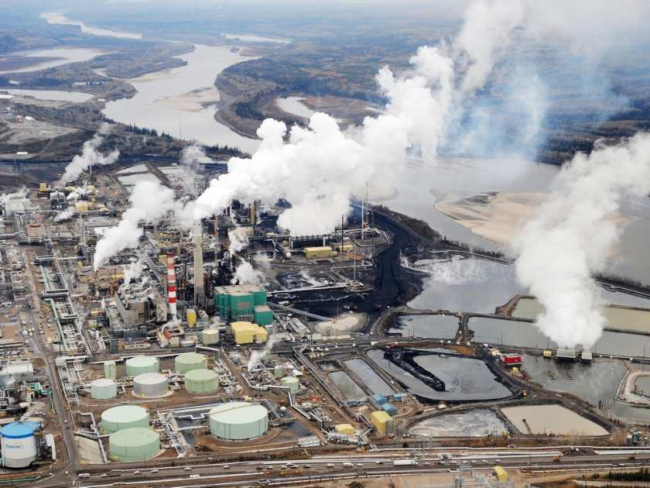Articles Menu

[Website editor: Alberta could 'potentially reduce the greenhouse gas emissions of oilsands operations by 13 to 16 per cent' by using hydroelectric power. Why trash just one region when we can trash two in order to trash the world's climate even more?]
VICTORIA — The B.C. Liberals have lately promoted building a new electrical transmission link to Alberta as a way to sell green power to a neighbour while attracting federal infrastructure dollars for job creation.
But a recent study argues that Alberta could also benefit from such an undertaking, by using B.C.’s comparably clean hydroelectric power to reduce greenhouse gas emissions from the energy-intensive development of the oilsands.
“Using hydroelectric power to meet oilsands electricity demand can potentially provide an option to reduce GHG emissions,” says the report published earlier this year by the Calgary-based Canadian Energy Research Institute.
“Furthermore, despite the high initial cost, the lower operating cost and long operational life of hydropower plants and associated transmission lines can potentially reduce the cost of electricity …. Once developed, a hydroelectric plant can provide a clean reliable supply of electricity for a long period.”
The institute surveyed a half-dozen options for the supply of hydroelectric power, including construction of a new dam and generating station on the Slave River near the provincial border with the Northwest Territories. Another possibility considered was a partnership with Manitoba to develop a dam at a site on the Nelson River.
The B.C. possibilities were two-fold.
One option had the two provinces proceeding with plans to upgrade the existing transmission link — “the intertie” — between their respective power grids, thereby allowing Alberta to purchase surplus electricity from B.C. in relatively short order.
Longer-term they could construct a dedicated power line — for either alternating or direct current — to link the oilsands and the already-under-construction hydroelectric dam at Site C on the Peace River.
The Alberta-B.C. intertie was rated the low-cost alternative, entailing as it did an investment of only about $300 million in current dollars to enable the existing link between the two provinces to operate at full capacity.
“The B.C. Intertie option also has the advantage of being able to deliver low greenhouse gas intensive electricity in the near term (within 2-5 years). Furthermore, as the B.C. Intertie option would utilize existing electricity infrastructure, it would lead to zero to minimal new environmental and social impacts.”
But the research institute’s findings on that option came with a caution.
“One main factor that leads to uncertainty in the viability of importing hydroelectric power from B.C. is the high forecasted electricity demand growth in B.C.,” said the report. “The BC Hydro system appears to run into electrical energy and capacity shortages in the early 2020s. Therefore, it is uncertain whether the B.C. hydropower options would be able to export large volumes of base load electricity into oilsands operations in Alberta.”
Site C might provide greater confidence on that score since the project is expected to be running by 2024. However, the B.C.-based hydroelectric dam did not fare as well in the cost comparisons to the Alberta-based or Manitoba options.
Then again, in strictly financial terms, the analysis concluded that none of the hydro projects could compete with the truly low cost alternative of building a natural-gas fired generating plant at the oilsands themselves.
The B.C., Alberta and Manitoba hydro dams were each costed in the $9-billion range in capital costs plus a further $2 billion to $3 billion for the transmission line.
An equivalent capacity gas-fired plant could be built for less than $3 billion, all-in, there being no need for the transmission line since it would be located adjacent to where the power would be needed.
But that’s not the end of the story. The main point of the study was to consider ways to reduce the emissions associated with development of the oilsands. Burning natural gas to make electricity would increase emissions.
But the research institute calculated that Alberta could “potentially reduce the greenhouse gas emissions of oilsands operations by 13 to 16 per cent” by substituting hydroelectric power for coal- and natural gas-fired electrical generation.
This at a time when the Alberta government has embarked on an ambitious plan to phase out coal-fired generation and build public acceptance for further development of the oilsands. The province is also phasing in a carbon tax at $30 a tonne, the rate already in place here B.C.
Against that backdrop, the hydro option looks more plausible, as the report itself said: “Without a price on greenhouse gas emissions, the likelihood of hydro power options reducing the marginal cost of oilsands operations is low.”
But even with the spur of carbon taxes and the drive to reduce emissions, most of the options discussed in the report would entail major financial risks.
“Development of the hydropower plants and transmission systems require massive amounts of irreversible capital investments,” says the research institute. “Therefore, the viability of implementation of any of the hydropower options assessed in this study depends on providing the project developers the certainty of capital cost recovery.
“Moreover, development of these hydropower plants would lead to environmental and socioeconomic impacts that extend beyond the jurisdictions in which they would be sited,” whether it be B.C., Manitoba or Alberta. “Therefore, greater levels of inter-jurisdiction coordination and stakeholder consultation is vital for the successful implementation of any of these hydropower generation and transmission options.”
For B.C. to begin providing hydro power to Alberta, it would surely take an act of political will by governments in both provinces, probably with Ottawa’s support as well.
But that is a topic for another day.
Above photo: MARK RALSTON / AFP/Getty Images